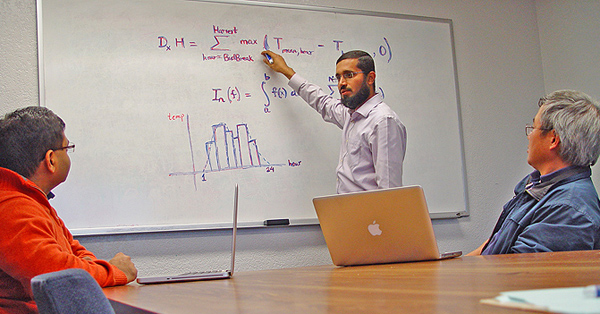California Agricultural Technology Institute
Taking a new approach to degree days...
Fresno State research team eyes better method for analyzing climate data for wine grape production

Fresno State Mathematics Professor Adnan Sabuwala (at whiteboard) discusses new approaches
to degree day formulation with Viticulture Professor Sanliang Gu (right) and research
associate Hemant Gohil.
If you are a wine grape grower in California then the number 1500 GDD might be important to you. It is the number of “growing degree days” (in degrees Celsius) generally considered optimum for growing premium quality red wine grapes such as Cabernet Sauvignon and Merlot.
Basically, the term GDD is a way of describing how much heat a grape vine (or any other plant) is exposed to during the course of a growing season. It is calculated using a mathematical formula based on an average of daily minimum and maximum temperatures. The formula provides a scientific basis for deciding what type of wine grapes to grow in a given region, since some varieties thrive under relatively cooler temperatures, while others can endure more heat and still produce a good quality crop.
According to scientist Sanliang Gu, Ricchiuti Chair of Viticulture Research for Fresno State’s Department of Viticulture and Enology, a more accurate method for determining total heat exposure for grapevines could enable growers to make better choices about planting and other management strategies, so with the encouragement of the wine grape industry, he has teamed with Assistant Mathematics Professor Adnan Sabuwala to develop a better method for determining heat summation and thermal distribution – based on hourly temperatures rather than daily averages.
“We hope this research will result in a significant improvement for climatic analysis,” Gu said in explaining his work. “Using degree hours and hours at a degree will allow for better interpretation of heat accumulation and thermal distribution, providing better classification of the wine grape production regions and more accurate evaluation of the growing seasons. It will also denote key periods of vine growth, berry formation, and fruit ripening.”
Hourly temperatures are available from the California Irrigation Management Information System (CIMIS) operated by the California Department of Water Resources. CIMIS has weather stations all over the state, recording temperature, rainfall and other climate conditions for use by agriculture.
Developing a heat exposure model based on hourly temperature recordings offers several advantages, Gu said. For example, existing GDD systems using average daily temperatures cannot take into account how long the temperature might be in an optimal range for grape color and flavor development. A formula based on hourly readings would.
In developing the new method, “we will also explore the use of hours at each degree to interpret the thermal distribution for key periods of vine growth, berry development and fruit ripening,” he said.
Gu envisions data collection going back as needed 10 to 20 years. It will involve collecting readings from major CIMIS stations close to prime viticulture regions. Fresno State colleague Sabuwala will develop mathematical modeling and calculations for the new method.
The research project is strongly supported by industry, Gu said.
“Members of the California grape and wine industries consider the research long overdue and the potential findings most useful,” he said. “They believe the work represents a major advance in the characterization of wine grape growing climates.”
Gu anticipates the project results will lead to new directions for climate analysis. The work also will provide the research communities and wine grape industry with a better tool to predict not only phenology and harvest dates but also fruit quality. When completed, the model can be extended to table grapes, raisin grapes, and tree fruits, he noted.
In addition to Sabuwala, a former Fresno State research associate, Hemant Gohil, will provide expertise in vine physiology as well as statistical analyses.
Gu said the team has already made two poster presentations at a research conference. They will continue to disseminate their findings to the research community, grape growers and other industry members at professional and industry meetings and through print and online media. For more information contact him at sanliang@csufresno.edu
Partial funding for this project was provided by the California State University Agricultural Research Institute (ARI), with additional support provided by several industry partners.
.